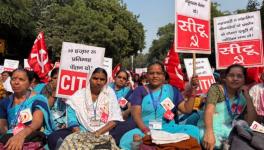Budget 2018 is Bad News for India’s Already Ailing Health System

Newsclick Image by Sumit Kumar
The Indian public health sector is falling apart. The country is among the lowest spenders on health—and the lowest among the BRICS nations—with the combined spending of the Centre and states hovering around 1.4% of the GDP.
In the absence of adequate public health services to take care of the over 1.3 billion population, we’ve seen the horrors wreaked by the profiteering and apathetic private health sector.
And the Union Budget 2018-19 only reduces the central government’s expenditure on health.
The total allocation in the budget for health for 2018-19 is Rs 54,600 crore. This amounts to 0.29% of the GDP, declining from 0.32% of the GDP in the last financial year.
It is, therefore, ironic—and dismaying—that the media has been hailing health as a winner in this budget. Even the National Health Policy 2017, approved by the Modi government itself, had recommended increasing the public health expenditure to 2.5% of the GDP. But that seems even more unlikely with the Budget 2018.
Perhaps the most worrisome aspect is that the government seems to not care about primary healthcare, particularly rural healthcare.
The government has reduced the allocation for the National Rural Health Mission (NRHM) from Rs. 25,458.61 crore to Rs. 24,279.61 crore. Under the NRHM (as pointed out here), there has been been a dire cut for reproductive and child healthcare (Rs 2,291 crore in nominal terms)—even as the country continues to have deplorable health indicators of maternal and child health.
According to the National Family Health Survey 2015-16, the infant mortality rate is 41 deaths per 1,000 live births. One in 20 children die before their 5th birthday, while 38% of children under age five are stunted. According to the World Health Organisation, 174 out of 100,000 Indian women die in childbirth.
One of the major announcements in the budget was the setting up of 1.5 lakh Health and Wellness Centres “as the foundation of India’s health system”, as envisioned by the National Health Policy 2017. It was announced that these “centres will bring healthcare system closer to the homes of people”. However, the allocation for these 1.5 lakh centres is only Rs 1,200 crore, which amounts to Rs 80,000 per sub-centre. This is quite meagre and not enough to meet the shortfalls.
The situation of the sub-centres right now is rather poor, with inadequate infrastructure and under-staffing. According to statistics quoted here, around 20% of the sub-centres do not have regular water supply and 23% do not have electricity. Over 6,000 sub-centres do not have an auxiliary nurse midwife (ANM)/health worker (female) while almost one lakh centres do not have a health worker (male). And 4,243 centres don’t have either.
As per Rural Health Statistics 2016, there is a 20% shortage of health sub-centres, 22% shortage of primary health centres and 30% shortage of community health centres.
The National Urban Health Mission has been allocated Rs 875 crore, up from 752 crore. Clearly, urban health has been given priority. Allocation for the Pradhan Mantri Swasthya Suraksha Yojana (which includes setting up of AIIMS-like institutes, upgradation of government medical colleges, etc.) increased by Rs 650 crore in nominal terms, but the allocation for upgrading district hospitals was reduced by 14.5% in real terms, as pointed out here.
Then, of course, is the announcement that has attracted the maximum attention—the National Health Protection Scheme—an insurance scheme aimed at benefitting 10 crore poor families by providing a yearly cover of up to Rs 5 lakh per household for secondary and tertiary care hospitalisation.
However, no allocation has been made for it, and it seems to be a repackaging of the Rashtriya Swasthya Bima Yojana (RSBY), which has been allocated around Rs 2,000 crore. This amount is clearly not enough to provide health coverage up to Rs 5 lakh per family for 10 crore households. Besides, the scheme has been criticized earlier for increasing out of pocket expenditure and exclusion of the poorest.
Previous experience has shown how insurance schemes only serve to add to the profits of the private hospitals, and even prompt hospitals to prescribe unnecessary procedures just because patients have insurance.
The idea in this budget seems to be that while the government cuts public expenditure to create a quality and affordable healthcare ecosystem, it is encouraging private players as well as patients to seek private help increasingly with the fillip of the insurance scheme, being billed as the world’s largest public-funded healthcare programme.
It is no wonder that 50.6 million people were pushed below the poverty line due to out-of-pocket spending on healthcare between 2004 and 2014.
Get the latest reports & analysis with people's perspective on Protests, movements & deep analytical videos, discussions of the current affairs in your Telegram app. Subscribe to NewsClick's Telegram channel & get Real-Time updates on stories, as they get published on our website.























